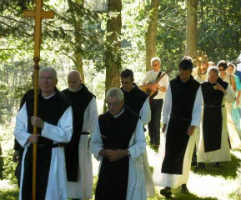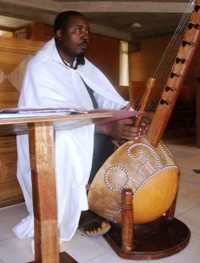-
1. Is it true that Trappists take a vow of silence?

Spencer
Trappist monks and nuns have a reputation of being silent persons. Somehow this impression, which has a certain foundation in reality, has led to the idea that they take a vow of silence, which has never been the case. In the average Cistercian monastery there are three reasons for speaking: functional communication at work or in community dialogues, spiritual exchange with one’s superiors or with a particular member of the community on different aspects of one’s personal life, and spontaneous conversation on special occasions. These forms of communication are integrated into the discipline of maintaining a general atmosphere of silence, which is an important help to continual prayer.
-

Chambarand
However, silence is included implicitly in one of the promises made by all Benedictines and Cistercians at the time of their monastic profession, five or six years after entering the monastery. They promise “conversion,” that is, fidelity to monastic life, a part of which is the discipline of maintaining an atmosphere of silence, and this requires controlling one’s tongue. Monks and nuns soon discover that speaking is not always the best form of communication. In fact it is frequently used as a coverup. A simple, silent, prayerful friendliness communicates something that goes far beyond words.
-
2. How is Cistercian life related to other forms of Christian life?

Val Notre Dame

Calvaire / Calvary
From the very beginning of Christianity the various forms of Christian life have been compared to different organs of a single, living human body which are called to serve each other in diversity and unity. Through the totally unique event of the death and resurrection of Jesus, believing Christians mysteriously form the one Body of Christ. “We are members one of another” (Eph 4:25). The Spirit of the Risen Christ inspires, unifies and, at the same time, diversifies this Body, which is the Church. The Cistercian or Trappist vocation is an integral part of this structure: a fruit of the Holy Spirit, in communion with the bishops of the Roman Catholic Church, at the service of the whole Church and the entire world.
In practice, the different Christian vocations continue the work and presence of Jesus throughout human history. Christ’s healing, teaching, preaching and service are embodied in persons and groups called to these ministries today. Trappists sense that the Spirit of Christ calls them to a life of simplicity, hiddenness, work, prayer, service and hospitality in a particular monastic community. This prolongs the many years of Christ’s hidden life with his family in Nazareth, the moments of his solitary prayer to the Father and the simple existence of his first disciples in Jerusalem. Such a life has been called the invisble “heart” of the Body of Christ.
-
3. Is the O.C.S.O. shrinking or growing?

Koutaba
Numerically and paradoxically, the Cistercian Order of the Strict Observance is both expanding and decreasing at the same time. The number of monasteries throughout the world has more than doubled in the past half-century: from 82 in 1940, to 170 at the beginning of the 21st century. In the 1940’s there was only one Trappist monastery in Africa and none in Latin America. Now there are around 20 in Africa and 14 in Central and South America. In Asia and the Pacific there were 6 houses, now there are more than 20. In general, the communities in Asia, Africa and Latin America are growing faster than the ones in other parts of the world.
During these same years, the total number of monks and nuns in the Order has decreased by about 20%. We are now slightly more than 2100 monks and slightly less than 1800 nuns worldwide, which makes an average of 23 members in each community, less than half as many as in former times. For more details on the different monasteries, see the page on Statistics

Humocaro
-
4. How can I learn more about the life of a monk or nun?

Maria Frieden

Kopua
Every human person carries a hidden “monk” inside. We are made for God. Monastic life corresponds to this need to live completely for God, both individually and as a member of a community. Since prayer is at the heart of a monk’s life, you can learn about monastic life at any time by setting aside 10 or 20 minutes each day for your own prayer, meditation and reading of the Scriptures, especially of the New Testament. Prayer like this is especially important if you are searching for your place in life, your vocation, above all if you think that God may be calling you to a monastic community.
Usually the best way to learn even more about a monk’s life is to spend a few days in the guest house of a monastery. It is always good to write or telephone first, in case the guest house is full when you plan to make your visit. Once in the guest house, you can speak freely with the monk or nun responsible for the guests, who can answer any further questions. If you cannot visit a monastery, reading about monastic life is helpful and it is usually possible to correspond with the sister or brother responsible for receiving the guests. Also, most of our monasteries have their own websites, with at least a small amount of information about the life. For address and website information for all Trappist monasteries, visit our Monasteries section.

Val Notre Dame
